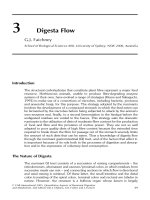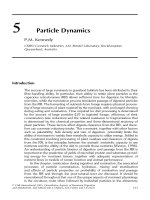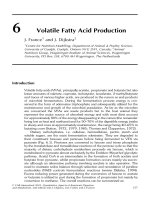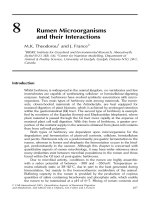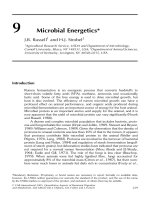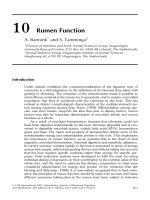Tài liệu Quantitative aspects of ruminant digestion and metabolism - Phần 15 pptx
Bạn đang xem bản rút gọn của tài liệu. Xem và tải ngay bản đầy đủ của tài liệu tại đây (205.13 KB, 28 trang )
20
Pregnancy and Fetal Metabolism
A.W. Bell,
1
C.L. Ferrell
2
and H.C. Freetly
2
1
Department of Animal Science, Cornell University, Ithaca, NY 14853, USA;
2
USDA ARS, Meat Animal Research Center, Clay Center, NE 68933, USA
Introduction
This chapter deals with quantitative aspects of macronutrient metabolism and
its regulation in maternal and conceptus tissues in vivo, emphasizing data and
concepts generated or revised during the decade since publication of a similar
chapter in the first edition of this book (see Bell, 1993). Recent findings on the
regulation of nutrient partitioning among maternal tissues, the placenta
and fetus(es) are highlighted, as is new information on placental transport
mechanisms.
Energy Cost of Pregnancy
Practical considerations
Meeting the nutrient requirements of pregnant females is important to ensure
an adequate nutrient supply for proper growth and development of the fetus, to
ensure that the female is in an adequate body condition for birth, lactation and
rebreeding, and to provide immature females with adequate nutrients for
continued growth. Recognizing those needs, most feeding systems currently
in use for ruminants (e.g. AFRC, 1990; CSIRO, 1990; NRC, 1996, 2001)
recommend a factorial approach such that estimates of nutrient requirements
for maternal maintenance, body weight gain and growth of gravid uterine
(or conceptus) tissues are summed to derive total requirements for pregnant
females. This approach implies that fetal nourishment will be adequate if
maternal body weight, condition and growth are maintained at suitable levels.
Limited or no interaction among tissues (or nutrient needs) of the gravid uterus
and maternal tissues is also implied by this approach.
ß CAB International 2005. Quantitative Aspects of Ruminant Digestion
and Metabolism, 2nd edition (eds J. Dijkstra, J.M. Forbes and J. France)
523
Recommended levels of feeding during late gestation range from about 1.7
times maintenance in cows and ewes with single fetuses to 2.2 to 2.4 times
maintenance for those with twins or triplets. Unfortunately, these levels of
intake are frequently not achieved, especially by polytocous animals, during
late gestation. Inadequate consumption may result from inadequate availability
or quality of diet and from depressed voluntary intake of cattle and sheep during
late gestation (Forbes, 1986). Under many production situations, maternal
body tissues must be mobilized during late gestation to sustain adequate nutrient
supply and growth of gravid uterine tissues (Robinson et al., 1999).
The increased energy used by the pregnant ruminant is reflected by
greater rates of heat production as compared to otherwise comparable
non-pregnant animals. Brody (1945) described the increase in heat production
of pregnant animals relative to similar, well-fed non-pregnant animals as the
‘heat increment of gestation’. He concluded (p. 429) that the heat increment of
gestation includes: (i) the energy expense of maintenance of the pregnant
uterus; (ii) ‘work’ of growth; (iii) increased work of the maternal organism
(including circulatory, respiratory and excretory activities); and (iv) endocrine
influences on metabolism of the mother. The physiological basis for this
increased metabolism and its implications relative to apparent energetic effi-
ciency of fetal growth are discussed in the following sections.
Growth and energetic efficiency of the gravid uterus
Energy content of the gravid uterus (allantoic and amnionic fluids, fetus,
placenta and uterus) or fetus increases exponentially in the sheep (Rattray
et al., 1974a) and cow (Ferrell et al., 1976a). Similar patterns are seen in
goats and other species. This pattern of growth results in about 90% of
birth weight of the calf or lamb being achieved during the last 40% of gestation.
Thus, energy retention in gravid uterine tissues is small during early gestation
(0.3 MJ/day at 130 days in the cow), but becomes relatively large near
term (4.9 MJ/day at 280 days). In comparison, net energy required for main-
tenance of a 550 kg cow is expected to be 36.6 MJ/day. Several researchers
have estimated the efficiency of utilization of dietary metabolizable energy
(ME) for energy retention in the gravid uterus or conceptus to be about 0.13
(AFRC, 1990; CSIRO, 1990; NRC, 1996). This value does not appear to
vary much with stage of gestation (Rattray et al., 1974b; Ferrell et al., 1976b)
even though absolute rates of fetal growth differ tremendously, but varies
to some extent with quality of diet (Robinson et al., 1980). Comparable
estimates of the efficiency of ME use for maintenance (k
m
) and postnatal
growth (k
g
) are typically about 0.70 and 0.40, respectively, for good
quality diets. Estimates of the ME required for pregnancy during late gestation
in a 550 kg cow (37.5 MJ/day at 280 days) are about 72% of that required
for maintenance (52.2 MJ/day). The difference between ME required
for gestation and energy retained in the gravid uterus is reflected as heat
production (or heat increment of gestation). Thus, about 87% of the
ME required to support pregnancy is dissipated as heat. These observations
524 A.W. Bell et al.
frequently have been interpreted to imply that gestation is energetically very
inefficient.
Reynolds et al. (1986) reported that heat production of the gravid uterus in
cows was 1.37, 2.12, 4.87 and 8.57 MJ/day at 137, 180, 226 and 250 days
of gestation, whereas the heat increment of gestation at these times was 2.69,
7.36, 12.34 and 14.95 MJ/day (Brody, 1945; Ferrell et al., 1976b). These
data were interpreted to indicate that 30% to 57% (mean 44%) of the heat
increment of gestation was attributable to the energy expenditure of the gravid
uterus. It is implied that over 50% of the heat increment of gestation in the cow
was associated with metabolism of maternal tissues. Freetly and Ferrell (1997)
estimated that 49% of the heat increment of gestation in ewes was attributable
to gravid uterine tissues. They showed that maternal hepatic oxygen consump-
tion increased during gestation in ewes and that increased hepatic metabolism
accounted for about 20% of the heat increment of gestation. Rosenfeld (1977)
observed that cardiac output increased about 75% during pregnancy in ewes,
supporting the suggestion of Brody (1945) that increased heart work contrib-
utes to the heat increment of gestation. Increased energy expenditure of
other maternal tissues such as kidneys, pancreas, skin and mammary gland
contribute to the heat increment of gestation.
Gross efficiencies of energy accretion in the uteroplacenta and fetus can be
estimated as energy accretion divided by the sum of energy accretion and heat
production. Resulting estimates of gross efficiency for the uteroplacenta and
fetus were relatively constant across stage of gestation (Reynolds et al., 1986)
and averaged 15.3% and 38.5%, respectively. Fetal energetic efficiency was
similarly constant at about 38% between mid- and late-gestation in sheep (Bell,
1986). Gross efficiency of fetal growth compares favourably with gross
efficiency of postnatal growth. Estimates of the gross efficiency of uteroplacen-
tal tissues were much lower. The simple reason for the difference in efficiency is
that oxygen consumption or energy expenditure per kg of uteroplacental
tissues is nearly twofold that of the fetus, but rate of energy accretion is
considerably less. Some of the reasons for the high energy expenditure of
uteroplacental tissues will be discussed in subsequent sections. Thus, although
growth of the fetus itself is rather efficient energetically, the entire process of
producing a calf or lamb is relatively inefficient because of the inefficiency of
energy accretion of the uteroplacenta, which is required to support fetal growth
directly, and because of the increase in maternal metabolism that is required to
support fetal growth less directly.
Maternal Metabolic Adaptations to Pregnancy
Patterns of macronutrient metabolism
During late pregnancy, ruminants generally increase their voluntary intake of
medium- to high-quality diets (Forbes, 1986) and, thus, the liver’s access to
glucogenic substrate of dietary origin (principally propionate and absorbed
amino acids). However, hepatic gluconeogenesis increases in ewes during late
Pregnancy and Fetal Metabolism 525
pregnancy even when feed intake is not increased above non-pregnant levels,
to an extent that is directly related to litter size and fetal demand (Freetly and
Ferrell, 1998). These results are consistent with earlier observations of the
effects of feed intake and pregnancy on whole-body glucose kinetics in sheep
(see Bell, 1993). Part of this increased gluconeogenesis is supported by in-
creased hepatic uptake of lactate (Freetly and Ferrell, 1998), apparently de-
rived from uteroplacental metabolism and increased glycolysis in maternal
peripheral tissues (Bell and Ehrhardt, 2000). A further portion is supported
by increased hepatic uptake of glycerol, especially if fat mobilization is in-
creased as term approaches (Freetly and Ferrell, 2000). Amino acids mobilized
from maternal carcass tissues (McNeill et al., 1997) also may help sustain an
increased rate of hepatic gluconeogenesis during late pregnancy.
Effects of pregnancy on the quantitative metabolism of amino acids have
yet to be studied systematically in ruminants. However, the fractional rate of
hepatic protein synthesis increased by 45% during late pregnancy in dairy
cows, at a time when intake of dry matter and nitrogen was declining (Bell,
1995). This is consistent with the moderate increase in hepatic protein accre-
tion (McNeill et al., 1997), and an apparent decrease in hepatic deamination of
amino acids (Freetly and Ferrell, 1998) observed in late-pregnant ewes. In
contrast, in ditocous ewes carefully fed to maintain zero energy and nitrogen
balance (CSIRO, 1990), there was a significant net loss of nitrogen from
carcass tissues during late pregnancy, attributed largely to mobilization of
amino acids from skeletal muscle (Fig. 20.1; McNeill et al., 1997).
Interpretation of putative pregnancy-specific adaptations in maternal lipid
metabolism in ruminants has been complicated by lack of experimental control
80 120 160
400
200
−200
−400
0
Protein deposition (g)
Dietary crude protein (g/kg)
Carcass
Organs
Mammary
a
a
a
ab
b
bb
ab
ab
Fig. 20.1. Crude protein deposition between days 110 and 140 of pregnancy in maternal tissue
components of ditocous ewes fed diets containing different levels of dietary crude protein. All
diets were designed to meet energy requirements. Histograms are means for eight ewes. Pooled
standard errors were 214 g for carcass, 84 g for organs and 44 g for mammary glands. Within
tissue components, means with different letters are significantly different (P < 0.05). Adapted
from the data of McNeill et al. (1997) and reproduced from Bell and Ehrhardt (2000).
526 A.W. Bell et al.
of nutrition and other environmental factors, such as photoperiod. For ex-
ample, early suggestions of apparent upregulation of adipose tissue lipogenesis
during mid-pregnancy (Vernon et al., 1981) were later mostly attributed to
seasonal (i.e. photoperiod) effects (Vernon et al., 1985). Also, the extent to
which decreased lipogenic capacity and increased fatty acid release in adipose
tissue during late pregnancy (Vernon et al., 1981) are due to pregnancy-
specific factors has been unclear due to lack of data on accompanying changes
in feed intake and energy balance. It is therefore notable that plasma concen-
trations of non-esterified fatty acids (NEFA), which are an excellent index of the
rate of mobilization of fatty acids (see Chapter 13), were moderately elevated
during late pregnancy in ditocous ewes that had been fed to maintain energy
balance in non-pregnant maternal tissues (Petterson et al., 1994). On the other
hand, there is little doubt that the decline in dry matter intake often observed in
cows and ewes close to term leads to an exaggerated increase in fatty acid
mobilization and plasma NEFA concentrations (Grummer, 1993; Freetly and
Ferrell, 2000).
Whole-body rates of entry and utilization of short-chain fatty acids, espe-
cially acetate, do not seem to be influenced by pregnancy beyond predictable
effects of the intake of rumen-fermentable organic matter (Bell, 1993).
Similarly, pregnancy-related changes in the kinetics of ketone bodies, especially
3-hydroxybutyrate, can be explained by changes in feed intake, energy balance
and the mobilization and hepatic catabolism of NEFA (see Chapter 13).
Homoeorrhetic regulation of nutrient partitioning
General concept
The concept of homoeorrhesis as applied to regulation of nutrient partitioning
during different physiological states, such as pregnancy and lactation, recently
has been revised and updated by one of its original proponents (Bauman,
2000). Key postulates of this concept include its simultaneous influence on
multiple tissues and functional systems, implying extracellular mediation, and its
operation through altered tissue responses to homoeostatic effectors such as
insulin, at various levels of extracellular and intracellular signalling.
Altered tissue responses to insulin and catecholamines
In sheep, as in humans and laboratory animals, late pregnancy is associated
with the development of moderate insulin resistance assessed by diminished
sensitivity to insulin of several variables of whole-body glucose utilization
(Petterson et al., 1993; Ehrhardt et al., 2001) and decreased insulin respon-
siveness of lipolysis and NEFA mobilization (Petterson et al., 1994). The tissue
sites of pregnancy-induced insulin resistance in sheep have not been quantita-
tively studied in vivo. However, the whole-body responses described by
application of the hyperinsulinaemic, euglycaemic clamp technique are con-
sistent with observations of increasing refractoriness of in vitro lipogenic
responses to insulin in adipose tissue with advancing pregnancy (Vernon
et al., 1985; Guesnet et al., 1991). This phenomenon may be partly mediated
Pregnancy and Fetal Metabolism 527
through decreased adipose expression of the insulin-responsive glucose trans-
port protein, GLUT-4, as demonstrated in underfed vs. well-fed, late-pregnant
ewes (Ehrhardt et al., 1998). The latter study also demonstrated reduced
expression of GLUT-4 in skeletal muscle of underfed ewes. This is consistent
with the diminished ability of insulin to promote glucose uptake by muscle
in vivo in lactating vs. dry ewes (Vernon et al., 1990), considering the similar
characteristics of whole-body insulin resistance observed in ewes during late
pregnancy and early lactation (Ehrhardt et al., 2001).
In contrast, pregnancy appears to amplify the responses of adipose tissue
to lipolytic adrenergic agents. This was most conclusively demonstrated
by in vitro studies in which lipolytic sensitivity and responsiveness to the
specific b-adrenergic agent, isoproterenol, were progressively increased as
pregnancy advanced (Guesnet et al., 1987). This phenomenon has not been
studied systematically in vivo but the increase in plasma NEFA concentration
provoked by a single intravenous injection of epinephrine was significantly
increased during late pregnancy in dairy cows (see Bell and Bauman, 1994).
The degree to which altered metabolic responses to insulin and
catecholamines during late pregnancy are physiologically specific and not
influenced by mild reductions in feed intake and energy balance requires
scrutiny. It is notable that moderate undernutrition markedly exaggerated the
decrease in insulin-dependent glucose utilization in late-pregnant ewes (Petter-
son et al., 1993). Energy deprivation also amplified the in vivo lipolytic
response to various adrenergic agents in non-pregnant, non-lactating cattle
(Blum et al., 1982).
Possible homoeorrhetic effectors
Several pregnancy-related hormones, including progesterone, oestradiol and
placental lactogen (PL) have been suggested as homoeorrhetic modulators of
observed changes in tissue responses to insulin and catecholamines, and asso-
ciated metabolic adaptations to the state of pregnancy in ruminants (Bell and
Bauman, 1994; Bell and Ehrhardt, 2000). A more recently suggested candi-
date is leptin (Bell and Ehrhardt, 2000), whose adipose tissue expression and
plasma concentration increase markedly in ewes during mid-pregnancy, inde-
pendent of nutrition and energy balance (Fig. 20.2; Ehrhardt et al., 2001).
None of these putative regulators has been shown to have the integrative,
pleiotropic influences that growth hormone (GH) has in lactating ruminants
(Bauman and Vernon, 1993; Bauman, 2000). Possibly, the combined
influence of these hormones is more significant than their varying individual
influences at different stages of pregnancy.
Among the sex steroids, oestradiol-17b (E
2
) may contribute directly or
indirectly to mediation of some metabolic adaptations, especially close to
term when there is a pronounced surge in plasma oestrogen concentrations.
Treatment of ovariectomized ewes with E
2
caused a reduction in rates of
adipose lipogenesis and fatty acid re-esterification in vitro (Green et al.,
1992). However, we were unable to discern any effect of a similar hormonal
treatment on responses of glucose or NEFA metabolism in vivo to insulin or
catecholamines, although basal plasma concentrations of glucose, NEFA and
528 A.W. Bell et al.
glycerol were chronically elevated in treated animals (Andriguetto et al., 1995,
1996). Oestradiol also may contribute indirectly to changes in lipid metabolism
through its inhibitory effect on voluntary feed intake in late-pregnant ruminants
(Forbes, 1986).
Definitive evidence of a homoeorrhetic role for PL remains elusive, but
such a putative role is hard to dismiss, for several reasons. First, this uniquely
placental peptide cross-reacts with both GH and prolactin receptors in rumin-
ant tissues (Gertler and Djiane, 2002). Its specific binding in ovine adipose
tissue increases with advancing pregnancy, implying increased influence on
lipid metabolism (N’Guema et al., 1986). Cross-reactivity with the GH receptor
would be consistent with the development of insulin resistance in adipose tissue
Pre-breeding Mid-
pregnancy
Late
pregnancy
Early
lactation
10
8
6
4
2
0
Plasma leptin, ng/ml
a
b
ab
a
4
3
2
1
0
Leptin mRNA, arbitrary units
a
b
ab
a
Fig. 20.2. Effects of physiological state on plasma concentration (upper panel) and adipose
tissue mRNA abundance of leptin (lower panel) in ewes fed to maintain relatively constant energy
balance and body fatness. Histograms are means for the same eight ewes studied at 20–40 days
before breeding (pre-breeding), 50–60 days of pregnancy (mid-pregnancy), 125–135 days of
pregnancy (late pregnancy) and 15–22 days postpartum (early lactation). Pooled standard errors
were 0.54 ng/ml for plasma leptin and 0.40 units for leptin mRNA abundance. Means with
different letters are significantly different (P < 0.05). Adapted from Ehrhardt et al. (2001).
Pregnancy and Fetal Metabolism 529
since GH is a potent homoeorrhetic effector of this response in ruminant
adipose tissue (Etherton and Bauman, 1998). Second, moderate undernutri-
tion enhances placental gene expression and secretion of PL in late-pregnant
ewes (R.A. Ehrhardt, R.V. Anthony and A.W. Bell, unpublished), coincident
with the decreased expression of GLUT-4 in maternal insulin-responsive tissues
(Ehrhardt et al., 1998) and exaggeration of indices of whole-body insulin
resistance (Petterson et al., 1993, 1994). Third, active immunization against
maternal ovine PL increased lamb birth weight, possibly via enhancement of
the bioactivity of PL and promotion of nutrient partitioning to favour the
conceptus (Leibovich et al., 2000).
The apparently pregnancy-specific increase in leptin expression and secre-
tion by adipose tissue in sheep (Fig. 20.2; Ehrhardt et al., 2001), together with
increasing evidence that leptin modulates the metabolic actions of insulin in
rodents (Ceddia et al., 2002), suggests that this peptide should be added to the
list of putative homoeorrhetic effectors of metabolic adaptations to pregnancy.
In addition, the abundant placental expression of the physiologically relevant
OB-Rb form of the leptin receptor (Ehrhardt et al., 1999) suggests that leptin
may act as a direct signal of maternal energy balance to the placenta.
Metabolism of the Conceptus
Placental nutrient transport and metabolism
As recently reviewed by Bell and Ehrhardt (2002), the energy and protein
requirements of the ruminant fetus are met mostly by placental transfer of
glucose and amino acids from the maternal to the fetal circulation, with the
addition of lactate produced by placental glycolysis. Long-chain fatty acids and
their keto-acid metabolites are poorly transported in sheep compared to spe-
cies with haemochorial placentation. Also, the maternal–fetal transfer of acet-
ate makes only a small contribution to fetal energy requirements, not
withstanding the abundance of this metabolite in the maternal circulation (Bell
et al., 2005). Therefore, this section will consider only mechanisms for pla-
cental transport and metabolism of glucose and amino acids.
Placental transport mechanisms
Glucose is transported from the maternal to the fetal circulation by carrier-
mediated, facilitated diffusion (see Bell and Ehrhardt, 2002). This process is
strongly dependent on the maternal–fetal plasma glucose concentration
gradient (Simmons et al., 1979; DiGiacomo and Hay, 1990a). The predom-
inant glucose transporter protein isoforms in the sheep placenta are GLUT-1
and GLUT-3 (Ehrhardt and Bell, 1997), mRNA and protein abundance of
which increase with gestational age, especially for GLUT-3 (Currie et al.,
1997; Ehrhardt and Bell, 1997). This, together with its low K
m
and localization
at the apical, maternal-facing layer of the trophoblastic cell layer (Das et al.,
2000), suggests that ontogenic changes in GLUT-3 expression and activity
may account for much of the fivefold increase in glucose transport capacity
530 A.W. Bell et al.
of the sheep placenta in vivo between mid- and late-gestation (Molina
et al., 1991). Other factors must include remodelling and expansion of the
placenta’s effective exchange surface and the increasing maternal-fetal plasma
concentration gradient (Molina et al., 1991).
Most amino acids taken up by the placenta are transported against a fetal–
maternal concentration gradient, implying the use of energy-dependent, active
transport processes (see Bell and Ehrhardt, 2002). Studies of isolated human
and rodent placental vesicles have confirmed that the transport systems in
the placenta are similar to those described for plasma membranes of other
tissues (see Battaglia and Regnault, 2001). These include at least six sodium-
dependent and five sodium-independent systems that have been classified
systematically on the basis of their affinity for neutral, acidic or basic amino
acids, and their intracellular location (Battaglia and Regnault, 2001). Recent
results from in vivo studies on sheep suggest that rapid placental transport of
neutral amino acids requires both sodium-dependent transport at the maternal
epithelial surface and affinity for highly reversible, sodium-independent trans-
porters located at the fetal surface (Jozwik et al., 1998; Paolini et al., 2001).
These researchers also demonstrated major differences in placental clearance
among the essential amino acids, with the more rapidly transported branched-
chain acids, plus methionine and phenylalanine, apparently sharing the same
rate-limiting transport system (Paolini et al., 2001).
Placental metabolism
Glucose entry into the gravid uterus and its component tissues is determined by
maternal arterial glucose concentration while glucose transport to the fetus is
determined by the transplacental (maternal–fetal) concentration gradient (see
Hay, 1995). In turn, the transplacental gradient is directly related to both
placental and fetal glucose consumption, which are dependent on fetal arterial
glucose concentration. Thus, as fetal glucose concentration changes relative to
that of the mother, thereby changing the transplacental gradient, placental
transfer of glucose to the fetus varies reciprocally with placental glucose con-
sumption.
In addition to its quantitative impact on placental transfer of glucose,
placental glucose metabolism has a major qualitative influence on the pattern
of carbohydrate metabolites delivered to the fetus. Rapid metabolism to lactate
($35%), fructose ($4%) and CO
2
($17%) accounted for about 56% of
uteroplacental glucose consumption in late-pregnant ewes, and was directly
related to placental glucose supply (Aldoretta and Hay, 1999). The fate of the
remaining 44% of glucose metabolized by the placenta must include synthesis
of alanine and other non-essential amino acids (Timmerman et al., 1998),
directly or via lactate (Carter et al., 1995).
Placental metabolism also affects the quantity and composition of amino
acids delivered to the fetus. The significant net consumption by uteroplacental
tissues of glutamate, serine and the branched-chain amino acids (Liechty et al.,
1991; Chung et al., 1998) implies catabolism or transamination of these acids.
An additional, small fraction of this net loss of amino acids will be in the form of
secreted peptides.
Pregnancy and Fetal Metabolism 531
The ovine placenta has very little enzymatic capacity for urea synthesis, but
produces considerable amounts of ammonia, much of which is released into
maternal and, to a lesser extent, fetal circulations (Holzman et al., 1977; Bell
et al., 1989). This is consistent with extensive placental deamination of
branched-chain amino acids to their respective keto acids, which are released
into fetal and maternal bloodstreams (Smeaton et al., 1989; Loy et al., 1990),
and with rapid rates of glutamate oxidation in the placenta (Moores et al.,
1994). Transamination of branched-chain amino acids accounts for some of
the net glutamate acquisition by the placenta, the remainder of which is taken
up from the umbilical circulation (Moores et al., 1994). That which is not
quickly oxidized combines with ammonia to synthesize glutamine, which is
then released back into the umbilical bloodstream (Chung et al., 1998). Quan-
titative aspects of ovine placental metabolism and fetal–placental exchanges of
branched-chain amino acids, glutamine, glutamate and their metabolites are
summarized in Fig. 20.3.
Uterine
circulation
Placenta Fetal
circulation
NH
3
NH
3
1.54.0
gln
5.73.5
glu
6.11.5
akg
TCA
bcaa
aka
18.9 10.9
Fig. 20.3. Net fluxes, measured in vivo, of the branched-chain amino acids, glutamine,
glutamate and ammonia into and out of the ovine placenta. Values are mmol per kg fetus per min.
Note the contributions of the branched-chain amino acids to both glutamate and NH
3
production
within the placenta. Abbreviations: gln, glutamine; glu, glutamate; akg, a-ketoglutarate; TCA,
tricarboxylic acid cycle; bcaa, branched-chain amino acids; aka, branched-chain a-keto acids;
NH
3
, ammonia. From Loy et al. (1990), Chung et al. (1998), and Jozwik et al. (1999); reproduced
from Battaglia (2000) with permission of the American Society for Nutritional Sciences.
532 A.W. Bell et al.
Similarly, the placenta almost quantitatively converts serine, mostly taken
up from maternal blood, to glycine (Chung et al., 1998), reconciling the
discrepancy between the negligible net uptake of glycine by the uterus and
substantial net release of this amino acid into the umbilical circulation (Bell
and Ehrhardt, 2002).
The complexity of interrelations among placental uptake, metabolism and
transport of amino acids was further illustrated by a study of alanine metabolism
in ewes during late pregnancy (Timmerman et al., 1998). Application of tracer
methodology showed that negligible net placental consumption or production
of alanine masks an appreciable metabolism of maternal alanine entering the
placenta which exchanges with endogenously produced alanine. Thus, most of
the alanine delivered to the fetus is of placental origin, derived from placental
protein turnover and transamination.
Fetal metabolism
Patterns of growth and nutrient accretion
Numerous studies on pregnant cows and ewes have described the energy and
nitrogen requirements for pregnancy based on heat increment of gestation of
the pregnant female and/or weight, energy, nitrogen (or crude protein) and
mineral accretion of the fetus, conceptus or gravid uterus (see AFRC, 1990;
NRC, 1996, 2001). Those studies have been extremely valuable for describing
normal patterns of growth of gravid uterine tissues and for the purposes of
establishing general nutritional requirements of gestating ruminants.
Weight, energy content and nitrogen content of bovine fetuses on different
days of gestation (Ferrell et al., 1976a) are shown in Table 20.1. Estimated
daily accretion rates and accretion rates relative to fetal body weight (relative
growth rate) are also shown. In the bovine fetus, rates of accretion of weight,
energy and nitrogen, increase during gestation (Ferrell et al., 1976a; Bell et al.,
Table 20.1. Weight (Wt.), energy (E) and nitrogen (N) accretion of bovine fetuses.
a
Day of
gestation
Fetus
b
Rate of gain
c
Relative growth rate
d
Wt. E N Wt. E N Wt. E N
100 0.48 0.76 5.01 17.9 38 0.2 37.05 78.14 0.415
130 1.37 2.99 16.30 45.1 130 0.6 32.82 94.61 0.437
160 3.45 9.96 47.28 98.6 372 1.6 28.57 107.76 0.463
190 7.63 27.97 122.6 185.8 883 3.6 24.34 115.68 0.472
220 14.86 66.32 283.6 298.6 1720 7.3 20.09 115.72 0.491
250 25.48 132.72 586.0 403.9 2695 12.9 15.85 105.75 0.506
280 38.47 224.18 1081.0 446.6 3285 19.8 11.61 85.39 0.515
a
From Ferrell et al. (1976a).
b
Fetal weight (kg), energy (kJ) and nitrogen (g).
c
Average daily gain of fetal weight (kg/day), energy (kJ/day) and nitrogen (g/day).
d
Growth rate of weight (g/day/kg), energy (kJ/day/kg) and nitrogen (g/day/kg) relative to fetal weight.
Pregnancy and Fetal Metabolism 533

